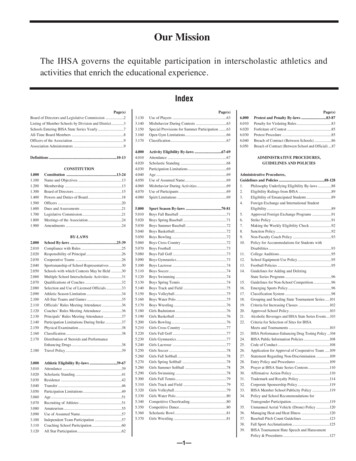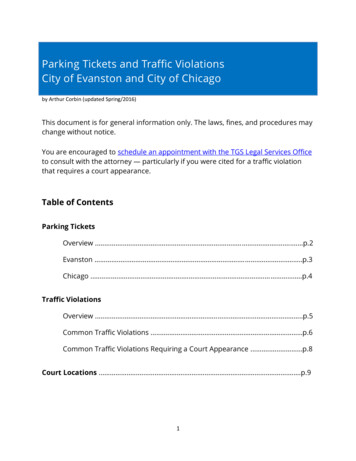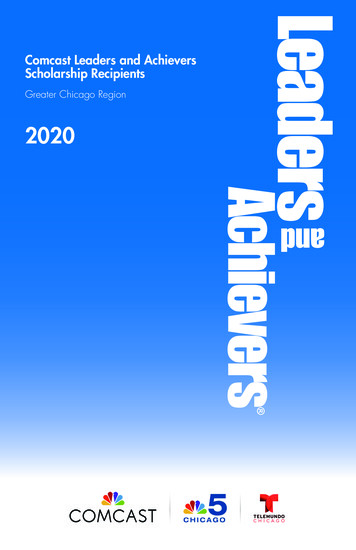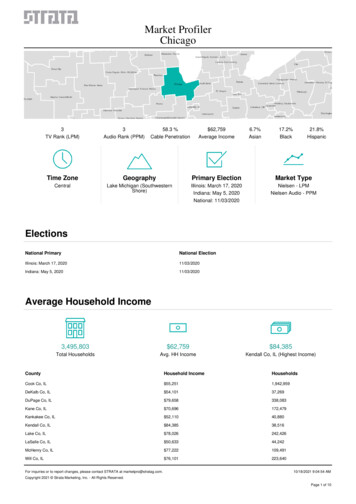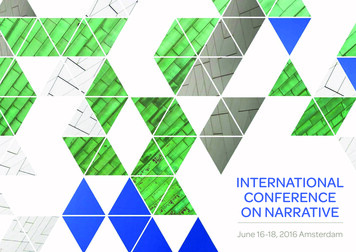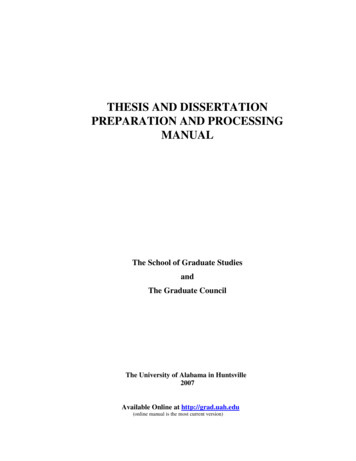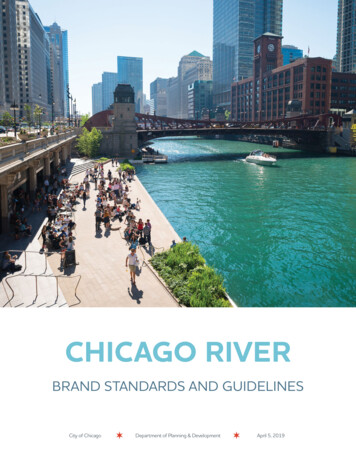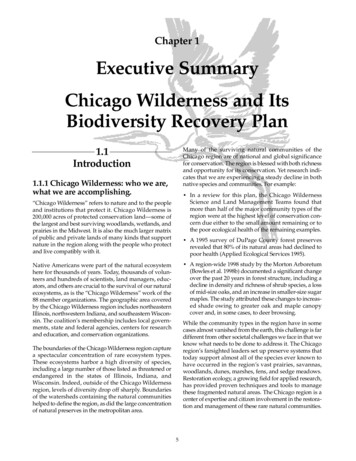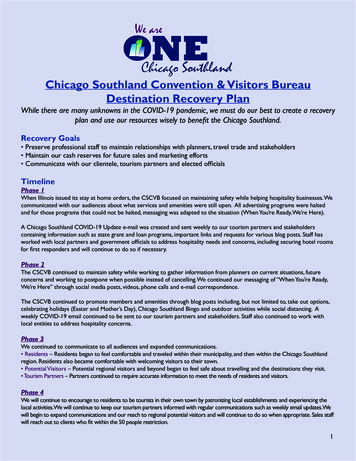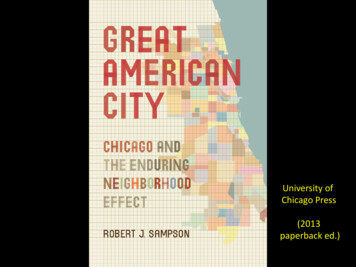
Transcription
University ofChicago Press(2013paperback ed.)
Violence and Child Well-Being Murder MurderRateRate
It matters where you have a heart attack or lose a letter
The Enduring Grip of Disadvantage During an Era ofSocial Transformation: Chicago Community Areas, 1960-2000
Persistent Concentrated Incarcerationin Black and White CommunitiesThe highestranked blackcommunityhas animprisonmentrate over 40times higherthan thehighest-rankedwhitecommunity(4,226 vs. 103per 100,000)
Legacies of Inequality and the Impact of the Great RecessionWashingtonParkRecentForeclosure“Hot Spots”
It’s Not Just Chicago:Durable Inequality in New York CityR J Sampson Science 2012;337:1464-1465
and Across the Nation:Durability of Concentrated Welfare Dependence Before and AfterFederal Policy to “End Welfare as we Know It”(N 64,902 Tracts in U.S. and 825 in Chicago, 1990-2000)R .89**R .88**Source: Sampson, 2011
“The spatial division of cities into districts orneighborhoods is one of the few universals of urbanlife from the earliest cities to the present.”Archeologist Michael Smith (2010)Chang’an (China) from astone map of A.D. 1080.Ilesha, a Yorubatown in the19th-century.
General Patterns Neighborhood concentration– Spatial inequality Across diverse social phenomena– “Things go together” Persistence despite change– The social order of the city
Theoretical Theme:Social Mechanisms & Processes(e.g., interactions, perceptions, control)Methodological Theme:“Eco-metrics” A metric for ecology
Project on Human Development inChicago Neighborhoods Longitudinal study of 6,200 children Longitudinal study of 343 neighborhoods
PHDCN CohortSampling: 19951. Stratified Random Sampleof 343 Chicago NeighborhoodClusters (N 80 Focal)2. Random Sample of Families( 4,500) with Children ( 6,200):MidwayAirportCohorts 0, 3, 6, 9, 12, 15 18
Ecometric Strategies Community Surveys of Residents Systematic Social Observation (SSO) Networks among Organizations and Elites Coding of “Collective Action” Events
Two Examples of Community ProcessesRelevant to Health Inequality:# 1. We asked over 10,000 ChicagoansWould neighbors take action if – children were skipping school?– a fight in the neighborhood?– city tried to close down the local fire station?How much residents – trust their neighbors– willing to help their neighbors– share same values
Collective Efficacy TheoryCommunitystructureMediatingmechanismRates ofwell-beingSpatial and macrolevel processesCollective efficacyConcentrated(dis)advantage;Residential stabilityViolence/disorder/Network ties;OrganizationsIndividual characteristicsand selection processeshealth
Result: Collective Efficacy (CE)Predicts Well-Being (Beyond Poverty)High CEMed. CELow CE murder
Changes in Collective Efficacy (CE) and Poverty Predict Homicide Trajectory(Adjusting for Changes in Racial Diversity and Residential Stability)- CE, - poverty CE, - poverty- CE, poverty CE, povertyHomicide rate per 100,0006.25.24.43.73.119962001Year2006
Not Just in Chicago:Similar Link to Violence in Stockholm NeighborhoodsLowMed.High
Example # 2: A Public Space in ChicagoIs this “Disorder”?Answer:Perceptiondepends onneighborhoodcontextCrime?- Health?Moving?
Perceptions are Deceiving:More Immigration Less Violence
InterlockingStructures
Residential Moves Create Cross-Cutting Network TiesDynamic FlowsWithin and OutsideCity Over 6 Years“Suburbs”& Beyond
Explaining Inter-neighborhood Flows Of Residential Exchange0.15Neighborhood clusters (N 80)Community areas (N 47)**0.10*Standardized -0.20**-0.25-0.30**-0.35Spatial% Black** p 0.01; * p 0 .05MedianincomeDensityCrime ratePerceivedFriend/Civic/org. Collectivedisorder kinship ties participation efficacyNeighborhood "distance"
City-Wide Network of Chicago Leaders
But: Masks Neighborhood Contextof Leadership Network StructureSouth Shore:Isolates and CliquesHegewisch:Cohesion Dominates
Higher-order or Citywide Structure of Elite-Generated TiesIrving eldParkLincolnParkSome communities are morelikely to serve as “connectors,”Some communities are moreeither city-wide or regionallylikely to serve as “connectors,”either city-wide or regionallyNearNorthSideWestTownNearWest rk
Neither Pure “Top Down” Nor “Bottom-Up:”An Integrated Theory of Neighborhood n& SocialProcessesIndividualChoice(“Selection”)
The New Social Transformation of the City Suburbanization of Poverty– “Inner-City” poverty is no longer the norm Historic Crime Decline Gentrification and the Public Housing Revolution Immigration Boom (1990-present)– “Smashing the black-white frame”? (Michael Katz) And then—Great Recession
New York City in the 1970s
“The Bronx is Burning ”
Rebirth of Cities (Not just NY) and Crime Decline# of people alive today that would not be otherwise hadthe 1992 homicide rate persisted: Over 100,000Magnitude of violence decline rivals increasesin “underclass” dislocations of the 70s and 80sE.g, NYC: 85% declineLos Angeles: 75% decline
Chicago Homicide Declines by Race/ethnicity of VictimsIndoorMurder& 700White60050040030020010001991 1992 1993 1994 1995 1996 1997 1998 1999 2000 2001 2002 2003 2004 2005 2006 2007 2008 2009 2010 2011Meanwhile, foreign born increase 50%
Other Dimensions of Social Change Teen pregnancy(-34% B, -29% W) Arrests(-33% B, -22% W) Life expectancy( 6.6 years BM, 3.7 years WM) Suburban poverty( 50% increase suburbs, 23% cities during the 2000s)
The Great Recession Intensified Neighborhood InequalityPoverty and Unemployment Rates in the U.S. (Census PUMAs):Pre (2005-07) and Post Great Recession (2009-11)Ann Owens and Rob SampsonPathways Magazine and Recession Trends (Russell Sage Foundation)
Transformation of Public Housing:Where the Robert Taylor Homes(25,000 residents) Once Stood
3 PROJECTS ADDRESSING THENEW SOCIAL TRANSFORMATION
Scaling up SSO:Chicago via “Google Street View”
“Divergent Pathways of Gentrification:Racial Inequality and the Social Order of Chicago Neighborhoods”Hwang, Jackie and Robert J. SampsonForthcoming—August 2014, American Sociological Review
Mixed-Income Project (MIP):An Integrated Longitudinal Study of Families and NeighborhoodsRobert J. Sampson & Robert D. MareFunded by the MacArthur FoundationPHDCNLAFANS
New Follow-Up (2012-2013) 1,072 Participants Recruited—PHDCN– Cohorts 0, 9, 12, 15 (now 15-32)– Field effort in Chicago and followed nationwide– 65% response rate after 12 years of no contact 1,032 Participants Recruited—LAFANS– 2 stages: Phone then field effort– 75% response rate after 5-6 years
Preliminary Results: Dynamics of Neighborhood Attainmentin the Adolescent to Young Adult Transition, by Race/EthnicityTrajectories of Neighborhood Poverty, Ages 9-26, Conditional on Baseline Covariates 1995199820022012
Preliminary Results: Dynamics of Neighborhood Attainmentin the Adolescent to Young Adult Transition, by Race/EthnicityTrajectories of Neighborhood Poverty, Ages 9-26, Conditional on Baseline Covariates 1995199820022012
BostonAreaResearchInitiativeCatalyzing a Cross-Disciplinary, Cross-UniversityUrban Research Agenda in the Age of Digital DataNational Science FoundationRadcliffe Institute for Advanced StudyJohn D. and Catherine T. MacArthur Foundation
Jane Jacobs Meets “Big Data”:The Eyes and Ears of the City
Full CRM database from March 1, 2010-June 29, 2012 334,874 cases with geographic reference Date and time of receipt Address or intersection 150 case types describing the type of services required(e.g., pothole, graffiti removal, medical) Anonymous code indicating unique caller 911 Over 1,000,000 call records 550 case types also with temporal/spatial resolution
Ecometrics for “Big Data”
PublicDenigration.75Trash.61GraffitiEcometrics for “Big Data”
PrivateNeglect.81.35.65Housing IssuesProblems w Big BuildingsUncivil Use of Space
Interpersonal Violence
Medical Emergency
CYCLES OF DISORDER AND VIOLENCE:Schematic Depicting Significant Cross-time Parameters (2011 2012)from Structural Equation Models, With Baseline Controls for MedianIncome, Racial Composition, and Collective Efficacy in 2010Source: O’Brien and Sampson, 2014 BARI Working Paper
Mapping Disorder and Medical Emergencies
Disorder and Medical Emergencies in South Boston
Drilling Down Further:“Hot Spots” of Private NeglectCan link tohistoricalrecordsfor eachaddress,e.g. codeviolations
Implications of Enduring NeighborhoodEffect for Community-Based Interventions Need Durable Policies to Counteract Persistent Inequality Salience of Social and Cultural Mechanisms– Collective Efficacy (cosmopolitan friendly)– Perceptions of disorder (contextual cognition)– Legal and moral cynicism (norms of legitimacy and altruism) Pivotal Role of Organizational and Leadership Networks Beyond Local Community– Spatial dynamics– Higher-order structure of connections and thus policy/evaluation “Big Data” and Urban Informatics for improving Governance
Pathways Magazine and Recession Trends (Russell Sage Foundation) Poverty and Unemployment Rates in the U.S. (Census PUMAs): Pre (2005-07) and Post Great Recession (2009-11) . (MIP): An Integrated Longitudinal Study of Families and Neighborhoods Robert J. Sampson & Robert D. Mare
